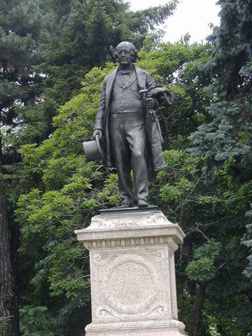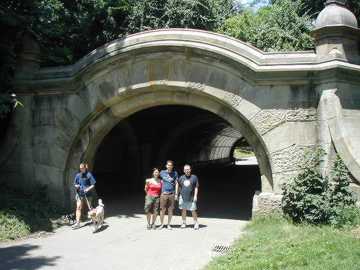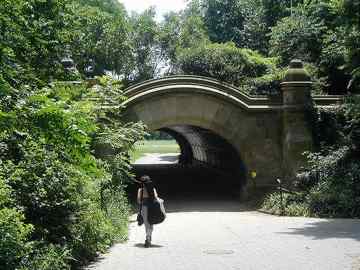When your webmaster lived in Bay Ridge, before 1993, I would often wander Prospect Park’s paths and would delightfully discover its massive arches and small wooden bridges, and spans seemingly made of boulders. I never forgot them; and the internet gives me the opportunity to indulge my affection for…

Manhattan’s Central Park isn’t about to be outdone by Brooklyn, which has its very own centrally located “greensward” that was designed and built by Calvert Vaux and Frederick Olmsted–the two men largely responsible for Manhattan’s oasis. Indeed, in many respects, Vaux and Olmsted believed they had, in fact, built a superior park to the one across the East River.

James Stranahan’s statue looks out over Brooklyn’s Grand Army Plaza.
Prospect Park is, in good part, the brainchild of railroad builder James Stranahan, who headed on a board of commissioners selected by New York State in 1859 to investigate areas to build a public park in Brooklyn similar to the one then under construction in Manhattan. Seven proposals were offered, including Ridgewood and Bay Ridge, which were then not in the city of Brooklyn proper. Another was on a hill called Mount Prospect, on the road that would become Flatbush Avenue near the Brooklyn-Flatbush town border. This location was selected, and the commissioners selected Egbert Viele, who was chief engineer of Central Park, to begin work on the project.
But Viele’s designs were torpedoed by the outbreak of the Civil War. At the conclusion of hostilities, the plan was placed in the more than capable hands of Olmsted and Vaux, who had landscaped Central Park before the war. Prospect Park was completed by 1870. After some very fallow periods, especially the 1970s, the Park today sparkles like a diamond in Brooklyn’s heart.
Calvert Vaux loaded Prospect with the same variety of ornamental bridges and arches that Central Park was endowed with. Here, we’ll take a look at them one by one. We will begin at Grand Army Plaza at Flatbush Avenue and Prospect Park West. Enter the park and bear right at the park path east of the auto drive. The first arch is dead ahead…


Forgotten Fans and dog walker at Meadowport, July 2001
Located: at western entrance to the Prospect Park Long Meadow south of Carroll Street. Built: 1868-1870; made mostly of Ohio sandstone

Meadowport Arch is a double-arched design,with the two arches facing different ways, a feature that makes it unique among Central and Prospect Park arches. Meadowport contains features of 17th Century Indian architecture, and its details have been compared to those of the Pearl Mosque in Delhi.
To find Meadowport’s sister arch, walk to your left across Long Meadow toward Flatbush Avenue….
Endale Arch, facing the Flatbush Avenue end
Located: at eastern entrance to the Prospect Park Long Meadow near the Brooklyn Public Library on Flatbush Avenue. Built: 1867-1868; made mostly of Ohio and New Jersey sandstone
Take a look through Endale Arch toward the Long Meadow on a bright day. The effect is remarkably like television, as the color and activity of the meadow is framed by the dark masonry.
The name “Endale” is a contraction of the arch’s original name, Enterdale, appropriate because of its location as an entrance to Long Meadow.
Endale Arch is supported by wooden timbers and poured concrete in boggy soil. The method was later repeated when building the towers of the Brooklyn Bridge a few years after Endale Arch was finished.
Its pointed arch signifies a Syrio-Egyptian influence in the design, architects say.
To arrive at our next Prospect Park bridge, stroll all the way down Long Meadow until you see the Prospect Park Picnic House on your right, the first building you can see from the meadow. There is a pathway that bisects the meadow here; turn to theleft and follow it, and soon you will see a stream which is crossed by…
Reminiscent of the wooden rustic bridges seen at intervals in Central Park, Esdale Bridge serves as the entrance to the Prospect Park Ravine, a hilly area in the park in which Olmsted and Vaux attempted to recreate the look of the Adirondack Mountains in upstate New York.
Esdale, which may appear completely wooden but has a steel and concrete core, bridges the Ambergill, an artificial stream personally named by Olmsted.
Ambergill Falls
Take an immediate left after crossing Esdale Bridge and walk the park path into the Ravine, admiring the stillness and the forest canopy. The Ravine’s present character is due to a recent restoration; it was a swamp until relatively recently.
Climbing a hill (known as Sullivan’s Hill, after the American general captured by the British during the Revolutionary War’s Battle Of Brooklyn) you will see, on your right…
Rock Bridge Arch overlooks Ambergill Falls (see above), which was reconstructed recently. Decades of wear and erosion had buried the original falls as constructed by Olmsted.
In the 1990s, park directors noticed that some standing boulders resembled those in Rock Bridge Arch. When crews began digging they uncovered the original stonework, which is today cleverly hidden by retaining walls.
On the way up the stairs, you will see a structure called the Rustic Shelter. A recent recreation, this octagonal structure has been built completely of cedar and tamarack logs, held together with pegs and dowels but not a single nail.
Prospect Park used to be studded with ‘rustic shelters’ like this one, but they’ve all been burnt down or destroyed in some fashion.
Prospect Park also used to have a Dairy, corresponding to the one in Central Park, in this part of the Park. The Dairy dispensed milk fresh from the cattle that were then herded in the Park. The Dairy fell to the wrecker’s ball in 1935, but the one in Central Park has been restored.
To find Rock Bridge Arch’s sister span, don’t cross it, but rather ascend the set of stairs on the path directly ahead….
Continue past the Rustic Shelter, climb another flight of steps and turn right. You will be at Rock Bridge Arch’s sister span…
Boulder Bridge takes a park path over a leg of the Prospect Park Bridle Path. It is built much like the previous Rock Bridge Arch.
This bridge replaced an earlier wooden bridge in the late 1800s. The boulders used to create the bridge were left here by a retreating glacier during the last Ice Age.
For our next arch, do not cross Boulder Bridge. Rather, backtrack the way you came, cross Rock Bridge Arch and follow the park path through the Ravine (which is presently marred by a chainlink fence while renovations are ongoing). You will arrive at a T intersection; go left, walk ahead a few yards and you will soon see…
Located: takes Center Drive over park path, bridle path and the Ambergill at roughly Prospect Park’s midpoint. Built: 1868-1870; made of Ohio sandstone and granite
Nethermead Arch takes its name from two Old English words, nether, below, and mead, meadow. Prospect Park Nethermead is a large open field set below the Ravine.
The change from the rather dark,sometimes forbidding Ravine is dramatic once you have passed under the Nethermead Arch, because you once again are in large open field filled with soccer and frisbee players (the effect is comparable to entering Long Meadow from Endale or Meadowport Arch). One of Olmsted’s favorite trees, an osage orange, greets the park walker as he enters the area.
Falls of the Ambergill, seen from Nethermead Arch on Center Drive
Like its cousin in Central Park, Eaglevale Bridge, Nethermead Arch has multiple vaults (Nethermead goes Eaglevale one better). Each arch has a different function: one allows foot traffic, another a bridle path, and the other the trickling Ambergill, to pass under Center Drive.
Note the trefoils (three-lobed designs resembling shamrocks) on the railing.
To locate our next bridge, climb up the steps to Center Drive and walk west (toward Windsor Terrace). The forest fills in again as we approach Quaker Hill, which contains a cemetery that was established by the Society of Friends before Prospect Park was built; burials here date to the 1820s. The park was simply built around it. Actor Montgomery Clift is buried here.
We’ll turn right on the first park path, though, before we arrive at the cemetery, and follow it a short distance until a small wooden bridge appears…
The path to Falkill Bridge was closed when this page was being written, so no picture right now. Resembling Esdale Bridge (see above), this recent recreation of an original Olmsted/Vaux design crosses the Falkill, the pool that is the source of Prospect Park’s running water. From here, water passes through two larger pools, the Ambergill, Binnenwater, Lullwater and ultimately into Prospect Park Lake.
After viewing Falkill Bridge it’s time to take a long walk to greet our next arch. Backtrack down the path you took to Falkill, cross Center Drive, watching for park vehicles and cyclists, turn right and then, at the first park path you come upon, turn left and cross the Nethermead. All this should take about 10-15 minutes of walking. The path joins another Prospect Park drive, known as Wellhouse Drive after a building that pumped water from the Prospect Park Reservoir, which existed from 1869 to about 1900.
From the park path, turn left on Wellhouse Drive and you will be crossing…
Terrace Bridge is the residue of much more grandiose plans and dreams that went unfulfilled.
Clay Lancaster in Prospect Park Handbook::
A terraced platform adjacent was to be provided with seats and awnings, and a small building ‘for the special accommodation of women and children, at which they may obtain some simple refreshment.’ An elaborate Eclectic stone tower was to have been built here, too, affording an even better vista of the bays and surrounding lands to the west…Midway between here and the Lookout, at the head of the inlet…was to have been built the Refectory, with broad arched terraces overlooking the water. The name of Terrace Bridge nearby recalls the project which, like the proposed structures on Lookout Hill, expired before realization. The Refectory was to have been ‘the principal architectural feature in the park’, like a well-appointed inn in the country.
The Refectory was one of Olmsted and Vaux’ ideas that never left the drawing board, however, due to a financial ‘panic’ in 1873.
View of the Nethermead from Terrace Bridge, showing decorative balustrade. The present Terrace Bridge replaced a wooden bridge in 1890 (the date is stamped on the arch).
Busy wasps have nested under the Terrace arch (the flute-like structure in the center is the nest)
Decorative bas relief under the Terrace span
From Terrace Bridge it’s a short walk down Wellhouse Drive to our next Prospect Park arch. Take a park path to your right which leads down to the Concert Grove, with its busts of Beethoven, Mozart and other luminaries. Robert Moses destroyed the original Concert Grove to make way for the Wollman Skating Rink in 1960.
Proceed through what remains of the Concert Grove, passing the 1874 Oriental Pavilion; coming up on your left is…
Located: takes Wellhouse Drive over park path near the Concert Grove, Oriental Pavilion and Camperdown Elm. Built 1871-72 of Beton Coignet concrete (sand, gravel, cement), its first use in the USA.
The ‘newest’ and most ornate of Prospect Park’s arches (excluding iron bridges such as Terrace, above). You’ll notice three separate colors as well as an interesting relief pattern in the vault.
Just a few feet ahead, past the Camperdown Elm (a ground-hugging elm tree derived from a cutting from a creeping Scotch elm at the Camperdown House in Dundee, Scotland in 1872) is Prospect Park’s most beautiful iron bridge…
Located: takes park path over an arm of the Prospect Park Lake known as the Lullwater for its stillness. Made of stone and cast iron; replaced an earlier oaken bridge from 1868 in 1905, when the adjacent Boathouse was also built.
Take a moment to explore the shores of the nearby Lullwater, check out the ducks, swans, dragonflies and bullfrogs.
Then, continue over the Lullwater Bridge,noticing that it could use a paint job, and continue on the park path through the woods past the nearby Nethermead. This is the same path we took to see the Nethermead Arch; we are again approaching it, this time from the south, but we’ll take a right turn long before we get there. The path we want is just before the 1887 octagonal Music Pagoda. The first path to the right before the Pagoda is what we need to get to…
Located: takes park path over the Binnen Waterfall south of the Pagoda and north of the Boathouse. Wooden, resembles Esdale and Fallkill Bridges.
The unusually-named Binnen Waterfall is not named for a Mr. Binnen, but it was bestowed by Olmsted on a waterfall of his own creation using the Dutch word for ‘within’. Binnen Bridge and Falls are truly in the depths of Prospect Park and it takes a seasoned parkgoer to find them, but when you do, you’ll be rewarded with moments of precious tranquility.
Binnen Falls is the southern extent of the Ambergill, as the stream makes its way toward the Lullwater and ultimately, Prospect Park Lake.
There used to be a nearby Binnen Pool, but over the years, it silted up. The pool is scheduled to be rebuilt soon, as will the Music Pagoda Bridge, which is presently a simple concrete walk with a fence of metal piping.
Continue over Binnen Bridge, follow the park path straight ahead, and our next span awaits.
Located: takes park path under East Drive east of Binnen Falls, and west of the Willink Entrance on Flatbush near Ocean Avenue; built in 1867-68 of sandstone and brownstone.
Named for its position on the east side of Prospect Park and not for America’s greatest actor, Eastwood Arch, believe it or not, is out last stop on our survey of Prospect Park’s arches and bridges.
Along with Endale Arch, Eastwood is the oldest Prospect Park arch. It shares with Endale a Syrio-Egyptian influence.
Sources:
Prospect Park Handbook, Clay Lancaster, Greensward Foundation 1967
Out of print, but used copies can be found via bookfinder.com
Complete and Illustrated Guidebook to Prospect Park and the Brooklyn Botanic Garden, Neil deMause and Richard J. Berenson 2001 Silver Lining Books, available at Barnes & Noble stores
Thanks to Neil deMause for assistance with this page
If you liked this page, you’ll like The Bridges of Central Park.
8/16/01